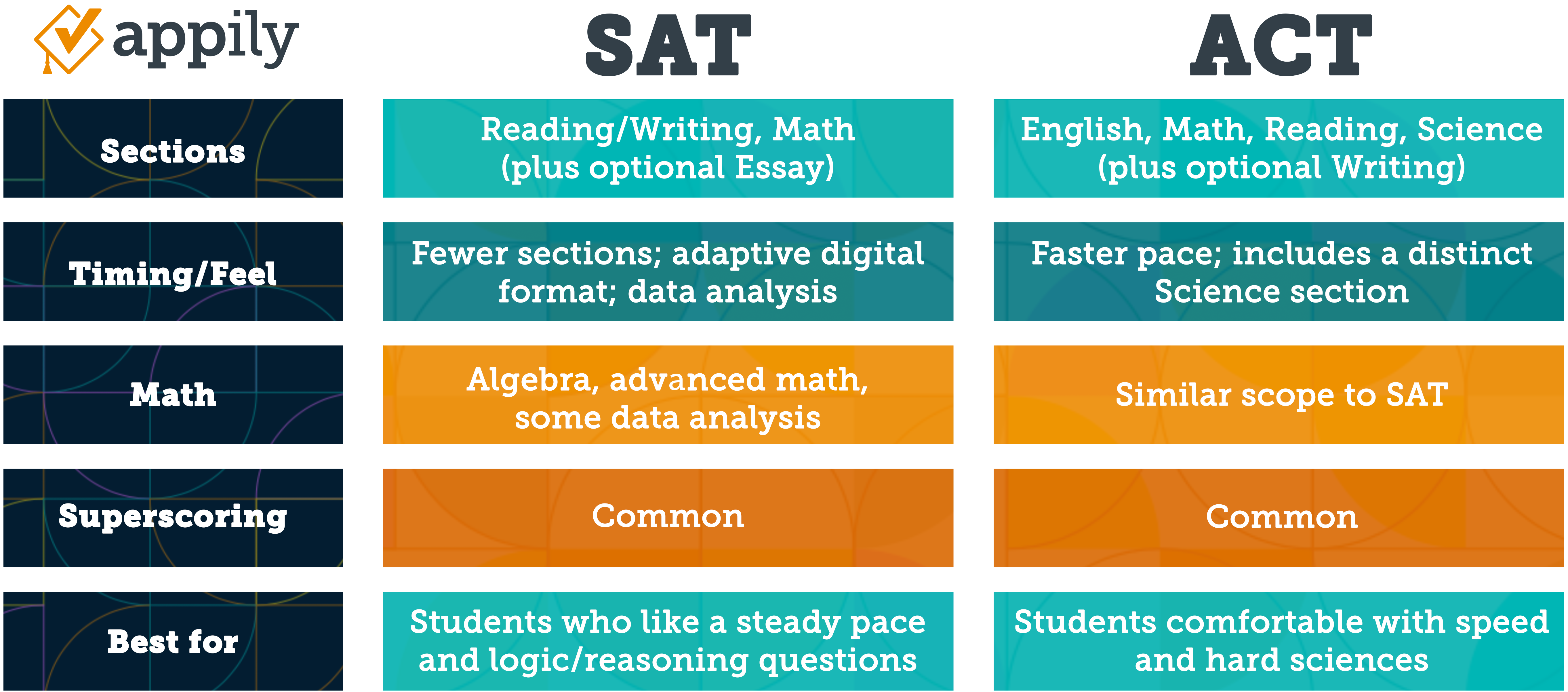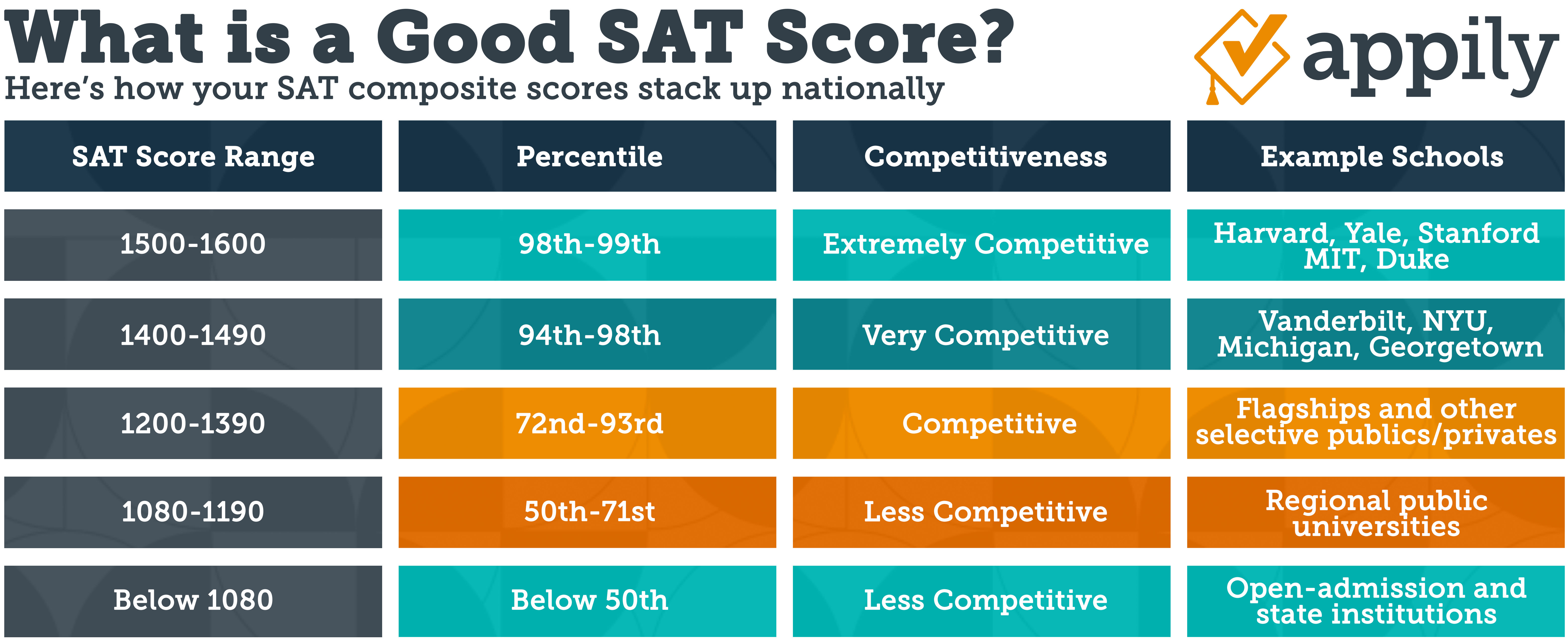What is a Good SAT Score in 2025? A Student's Guide

Your SAT score can open doors to colleges and scholarships, but you may be asking “What is considered a good SAT score?” Well, it depends on the schools you’re aiming for. Generally, the higher your score, the better your chances of acceptance into competitive programs. But remember, your SAT score is just one piece of the puzzle. Admissions officers also look at your grades, essays, extracurriculars, and more.
Still, doing well on the SAT is a great way to broaden your college options.
In this article, we'll explore the topic of SAT scores, including how they differ from the ACT, what scores and percentiles are considered competitive, and how you can prepare yourself for test day to achieve the best SAT score possible. Let’s dive into the details.
So, let's get started by looking at the key differences between the SAT and ACT, and how each test is scored.
SAT vs. ACT: What’s the Difference?
The SAT is a standardized test used by colleges and universities to make admissions decisions. It consists of three sections: Reading, Writing & Language, and Math, with an optional essay section (though most colleges no longer require it).
On the other hand, the ACT consists of four sections: English, math, reading, and science, with an optional writing section.
The scoring scales differ between the SAT and ACT. The SAT is scored on a scale of 400-1600, whereas the ACT is scored on a scale of 1-36. The SAT also allows slightly more time per question, but the questions often require more logical thinking than those on the ACT.
The SAT gives students a bit more time per question, while the ACT tends to move faster but features more straightforward questions. Many students who like science and data interpretation prefer the ACT, while others who enjoy reading and logic-based reasoning gravitate toward the SAT.
If you're wondering whether to take the SAT or ACT, then click that link.

How is the SAT Scored?
The SAT consists of two main sections:
- Reading and Writing: A 64-minute section with approximately 50 questions.
- Math: An 80-minute section with around 40 questions.
SAT total (composite) score
You will get a total score, which is the total of both individual section scores. The possible range is 400 to 1600.
SAT section scores
You will also receive section scores ranging from 200 to 800 for each section. Since you are not penalized for guessing, these are just the number of questions you answered correctly.
SAT Scoring at a Glance
- Total Score Range: 400–1600 (sum of two section scores)
- Sections: Math (200–800) and Reading & Writing (200–800)
- Perfect SAT Score: 1600
The adaptive testing process
Here’s how the adaptive nature of the test affects scoring:
- If you tackle harder questions in module 2, you’ll need fewer correct answers to achieve a high score.
- Students answering more straightforward questions may need to get more of them right to reach the same score.
Average SAT scores
Based on data from the College Board, here’s a quick look at average SAT scores from the 2024 cohort:
- Total Score: 1024
- Math: 530
- Reading and Writing: 480
These averages provide a helpful benchmark, but what’s “good” depends on your goals and the colleges on your list.

Pro Tip: Aim for the upper end of the middle-50% SAT range (25th–75th percentile) at your target colleges. That puts you in a stronger position for admission and, sometimes, merit aid.
Percentile rankings
Understanding where your score falls can help you gauge your competitiveness. Below is a detailed breakdown of composite SAT scores and their corresponding percentile rankings, offering a clearer picture of how your score compares to other test-takers:
| Composite Score | Percentile Rank |
|---|---|
| 1600 | >99 |
| 1550 | >99 |
| 1510 | 99 |
| 1500 | 98 |
| 1450 | 97 |
| 1410 | 95 |
| 1400 | 94 |
| 1350 | 91 |
| 1340 | 90 |
| 1300 | 86 |
| 1250 | 80 |
| 1220 | 76 |
| 1200 | 72 |
| 1150 | 64 |
| 1130 | 60 |
| 1100 | 57 |
| 1080 | 50 |
| 1050 | 44 |
| 1030 | 40 |
| 1000 | 34 |
| 980 | 30 |
| 920 | 20 |
| 830 | 10 |
| 770 | 5 |
| 650 | 1 |
| 640 | <1 |
| 400 | <1 |
The new Digital SAT
In 2024, the SAT transitioned to a digital format, bringing significant changes to improve the testing experience. The digital format offers faster scoring and fewer errors than old paper tests.
Other key updates include:
- Shorter Test Duration: The digital SAT takes 2 hours and 14 minutes, down from the previous 3 hours and 15 minutes.
- Calculator Availability: A calculator is now provided within the testing software for the math section.
- Adaptive Questioning: The digital SAT adapts to your performance. If you do well in the first set of questions (module 1), the second set (module 2) will be more challenging. If you struggle, the test adjusts to include easier questions. This adaptive format impacts both the difficulty and scoring of the exam.
These changes are designed to make the SAT more accessible and efficient but also require new preparation strategies.
Should I take the SAT?
With some colleges offering test-optional admission, you might wonder if taking the SAT is worth it. Here’s how to decide:
- Check Your Schools: Research whether the colleges you’re interested in require SAT scores. Even if they’re test-optional, submitting a strong score could give you an edge.
- Scholarship Opportunities: Many merit scholarships are tied to SAT scores. Taking the SAT might be a smart move if you're aiming for financial aid.
- It Really Can't Hurt: If you take the SAT and don’t like your score, you don’t have to submit it. Many colleges only consider your scores if you choose to share them.
The best way to decide is to evaluate your academic strengths and goals. If studying for the SAT could help you stand out, it’s worth considering.
You might also want to look at the ACT if you enjoy writing and like science.
SAT prep tips
If you decide to take the SAT, preparation is key. Here are some tips to help you succeed:
- Practice Tests: Take official SAT practice tests to familiarize yourself with the format.
- Focus on Weak Areas: Identify sections where you need improvement and target those in your study sessions.
- Time Management: Learn how to pace yourself to complete each section within the time limit.
- Use Free Resources: Platforms like Khan Academy offer personalized study plans based on your practice test results.
- Consider a tutor: A test prep tutor could be the answer if you need extra support.
Your SAT score & scholarships
Your SAT score doesn’t just influence college admissions. It can also impact your eligibility for scholarships. Many schools offer merit-based financial aid to students with high test scores and GPAs.
Additionally, the PSAT (often taken in your junior year) can qualify you for the National Merit Scholarship Program, giving you even more reasons to take standardized testing seriously.
Next steps
Now that you understand what’s considered a good SAT score and how it fits into your college journey, it’s time to take action:
- Research Colleges: Use tools like Appily to explore schools where your SAT score makes you a competitive applicant.
- Understand Acceptance Rates: If you know the acceptance rates of the school you're interested in, you can better understand how vital your test scores are. That can save you time and effort.
- Plan Your Test Prep: Set aside regular study time and use free and paid resources.
- Stay Positive: Remember, your SAT score is just one part of your application. Your grades, activities, and essays matter just as much.
See Your Chances of Admission with Your SAT Score
Ready to see how your SAT score stacks up?
Create a free Appily account to discover schools where you’ll shine. With the right preparation, you can open the door to incredible opportunities.
Know where you stand
See your chances of getting in at any college — in realtime. Get insights into your target, reach, and likely schools.
Frequently Asked Questions About the SAT
What is the best SAT score?
1600 is the highest possible. The “best” score for you is the one that strengthens your application at target schools.
Do SAT percentiles matter?
Yes—percentiles help you compare performance nationally and align with college ranges.
Are SAT scores required?
Many colleges remain test-optional, however this is beginning to shift. Submitting a strong score can still help—especially for competitive majors, scholarships, and out-of-state applicants.
Are Ivy League SAT scores super high?
Yes. Many Ivy middle-50% ranges cluster in the high-1400s to 1500s. Remember: admissions are holistic.